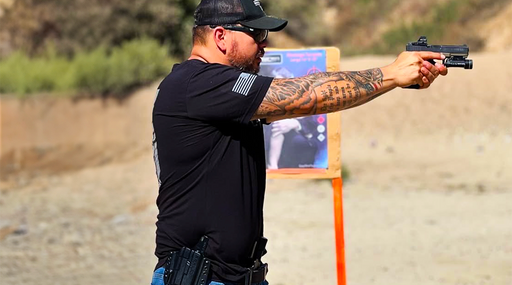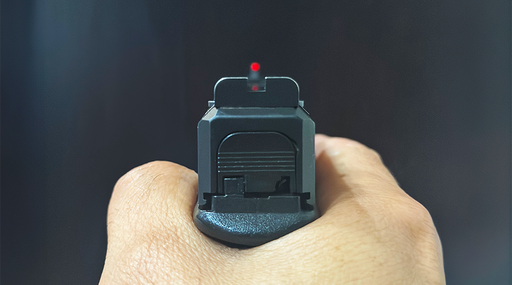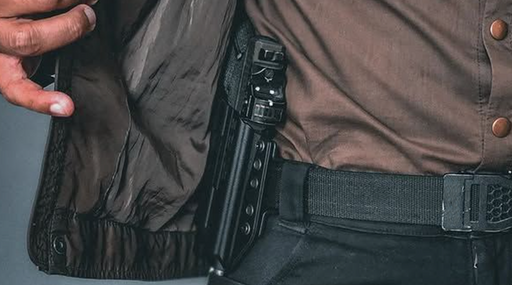Change Those Batteries!
By Abner Miranda
As I sit down this Monday morning to write this article, I’ve just returned from a weekend rifle class with Talon Defense. Defensive Carbine is a great class that focuses on running the gun from every conceivable angle. Lead instructor, Chase Jenkins, does an excellent job of making sure that as students we get a well-rounded view of the different skill sets needed to prevail in a gunfight. As the fight against terrorism has now been brought to our streets it’s incumbent upon us to recognize that static fighting is a fantasy. Moving and shooting around cover and concealment is the only way you’re going to survive. The class was superb, however, my performance in it had a few hiccups. Things would’ve gone smoother had I checked my optics battery before leaving home. Oops!

Master Your Iron Sights
I ran Defensive Carbine with my 9.25” Ballistic Advantage SBR slung on my Basham Single Point Sling. My secondary weapon was my EDC Glock 17 in a Bravo Concealment, RTT Light Bearing Holster with an INFORCE APL. I built my SBR to be short, fast, and light. At just over five pounds it’s the perfect CQC weapon. To help keep it agile I set it up with an Insight Technologies, MRDS. I’ve used these optics for years, to great success. If you look closely at my logo (Chuckles) you will see that sitting on top of that rifle is the MRDS. I’ve used the MRDS all the way out to 200 yards during a night class. So yeah I have no issues with the MRDS. I’ve worked barrier drills where I tracked moving targets and nailed them while cleanly working around a field of no shoots. I would feel comfortable calling myself competent with the optic. However, I somehow managed to be distracted last Friday when packing for the class and managed to miss the obvious, which was to open the optic up and take a look at the date on the battery. I date my batteries with a fine Sharpie marker when I replace them. This way, if I have an optics failure, I can see how long the battery has been in service to determine if it’s just the battery or possibly the optic going bad.
The battery failed within minutes of the weapon being in sunlight. The MRDS dimmed dramatically and I knew I was in trouble. I knew I had a spare somewhere but I couldn’t find it. I then stripped off the MRDS and ran the rest of the class with my backup sights.
When I first started shooting rifles, many years ago, red dots were very expensive. So by sheer default I learned how to shoot iron sites, quite well I might add. For those who’ve recently entered our industry, you need to understand that red dot optics are a very new thing. While red dots have been around for a long time they have only been perfected and made truly rugged within the last eight years or so. The two optics that really pushed the bar up are the Aimpoint Micro T-1, and the Insight Technologies MRDS.

Read Between The Lines
I think at this point in American history no one really needs to be arguing that we’re down to asymmetrical warfare. In the last six weeks we've had several terrorist attacks that completely defy everything we've ever seen. I would call this prima facie evidence that we need to stop ignoring the facts and recognize that speed, accuracy, and violence of action are the only way to prevail against a well armed and motivated killer.
The reason I’m focusing this article on small optics is because small shoulder mounted weapons are what we need to be bringing to the fight so as to throw the enemy off balance. How do you keep a small rifle small? By using a small, low profile optic, and possibly even foregoing a weapon light.
Simply put, an MRDS is the best way to ensure fast hits with the least amount of mechanical offset issues. The optic is small, and is mounted low to the top rail. These features are what allow it to dramatically minimize variance between point of aim and point of impact.
Where small optics come up short is in their diminished battery capacity, which really is the crux of this article. For example, an Aimpoint T–1 (everything I’m saying applies to the T-2 as well) uses a CR2032 battery which is considerably larger than the CR1632 used by the MRDS. You would think that a larger battery means more run time right? Well of course it does, the T-1 can run for 5 years without a battery change! Really? Let’s look at that one for a minute.
This is what the owners manual says “The T-1 has a 5 year battery life of continuous (day and night) use at pos. 8 of 12 and over 10 months at pos. 10 of 12.” Did you catch that? Read it again please.
The T-1 does not have a five year battery life, if you’re actually shooting with it. Position 8 is too dim for anything but indoor shooting, in low light. The instant you activate your weapon light that dot is washed out! If you push your dot up to 9 it jumps things up decently but you’re still going to lose that dot in a weapon light. The solution is that you have to run it somewhere around 10 to overcome your weapon light.
Now let's talk about daytime use. Anything less than position 10 and daytime use is worthless unless you’re shooting at something dark. Somewhere between 10 and 11 is more realistic for day use. Now look at those battery usage stats above and tell me just how much time you’re going to get out of your battery on settings 10 or 11. Yeah, I've learned this stuff the hard way. And remember this gets worse if you’re shooting in heat and cold.
Now let’s have a look at the MRDS battery numbers. The owners manual is really vague on power usage. All it says is “1 year continuous operation in photodiode mode.” Really!? That is what is known as poop! I’ve never, ever gotten 1 year of battery life out of my MRDS’s. By the way, photodiode mode simply means in automatic mode. I know someone out there is going to say “well I’ve gotten a year out of mine.” Sure, you can get a year of life out of these batteries as long as you never take your weapon outside. If you’re taking them out in the heat, cold, and direct sunlight you’re lucky if you get 7 months out of them.
If you take an MRDS into sunlight it cranks up it’s brightness. In darkness it drops down to a very dim setting. If you pop on a weapon light it sees that too and adjusts accordingly. All of that automation sucks up a lot of power and requires close attention to how long you’ve been running your batteries. The mentality that some folks espouse is to shut the optic off until they need it. This is flawed reasoning due to the fact that if you’re picking up a weapon because you need it you’re going to be dramatically short on time. All the function checks that you think you're going to do are going out the window while under stress. You’ll be lucky to remember to work your safety before pulling the trigger. Don’t believe me? Just yesterday in class I watched more than one student forget to take their safety off, and all we were doing was shooting at paper targets.
It's not their fault, gunfighting is extremely stressful. Even simulated stress will lock you up. When I was a cop I did some crazy things under stress and wondered why I’d done them.

Closing Thoughts.
I think that the most important take away from this article should be to never assume that your weapons and support equipment are good to go. To be on the safe side I would change optics batteries every six months. That’s what I’ve decided to do with all my optics. As of yesterday I swapped batteries on everything and marked them all with 7/16 on the rim of the battery. Come December I’m yanking them all and replacing them again to get onto a true six month schedule. I’ve been lackadaisical about keeping up with this and that ends now. It takes less than 60 seconds to create a reminder in your phone’s calendar for December and June. Do it, change all those batteries across the board. It’s only money. Besides, how much is your life worth to you?
As always, God bless you all, get those guns out and practice. Have a good one!

~Abner Miranda is a former Police Officer, an FBI trained Hostage Negotiator, a First Responder, and Spanish Interpreter. He is currently a Firearms Instructor, an Armorer, and a regular contributor to our industry of both written and digital media. You can see more of Abner’s work on his YouTube channel: https://www.youtube.com/user/daddycop3





















Leave a comment
2 comments
Very good Stuff. Thanks for Sharing, i think that’s the first time i have ever read someone admit that about Aimpoints.
I’ve seen a good amount of powered optics go down permanently and intermittently to know the risk. I’m using irons, and a detach mount with a milspec Aimpoint with two spare batteries onboard. I did some pretty thorough research into the probability of EMP effect on digital circuits and concluded it’s nearly impossible to get hit with a EMP powerful enough to take out handheld electronics. If you are close enough to an EMP you would not likely survive an event that could fry your optic. So it’s a non issue in my opinion, but irons will inevitably be needed at some point anyway. It bears further reflection on the possibility that the optics mechanical features fail. Great article, the training sounds fun. I trained under aggressive stress induced conditions in the military, but nothing prepares you for the real thing. When you realize you’re under attack, you can only hope to fall back onto your training, amd hope that you are fast enough, and aggressive enough to counter the attack and prevail.